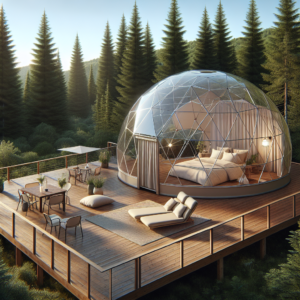
Article-at-a-Glance
-
GeoDomes are innovative greenhouses ideal for the Canadian climate, enabling year-round plant growth.
-
Key features include solar power harnessing, advanced climate control, and sustainable design materials.
-
GeoDomes offer solutions to food security by extending the growing season and supporting food independence.
-
Design considerations for a GeoDome include location, size, and the use of eco-friendly materials.
-
Community GeoDomes serve as educational tools, promoting sustainable agriculture practices.
Unlocking the Potential of Sustainable Greenhouse GeoDomes
As we face the challenges of a changing climate and a growing need for sustainable food sources, it’s time to turn our attention to solutions that can make a real difference. Greenhouse GeoDomes are not just a trend; they are a revolution in year-round, sustainable growing, especially in the diverse climates of Canada. I’m here to guide you through the benefits and practicalities of these structures, so you can understand why they are becoming an essential part of modern agriculture.
What Makes GeoDomes Perfect for Canadian Climates?
Let’s talk about the Canadian climate—known for its harsh winters and short growing seasons. Traditional farming methods can be challenging under these conditions, but that’s where GeoDomes come in. Their geodesic design is not only aesthetically pleasing but highly functional, offering unparalleled strength and the ability to withstand heavy snow loads and strong winds. This resilience is crucial for year-round growing in Canada.
-
GeoDomes can retain heat efficiently, which is vital during cold spells.
-
Their shape allows for maximum sunlight exposure, which is essential during shorter daylight hours.
-
GeoDomes are versatile and can be adapted to various terrains and environments.
Key Features of GeoDomes That Promote Sustainability

Sustainability isn’t just a buzzword; it’s a practice that GeoDomes embody through their very design. They incorporate features that reduce waste, conserve energy, and promote ecological balance. Here are a few key elements:
-
Energy Efficiency: The dome’s shape allows for even distribution of heat, reducing the need for artificial heating.
-
Water Conservation: GeoDomes can be equipped with systems that collect and reuse water, minimizing water usage.
-
Renewable Energy Integration: The design is ideal for integrating with solar panels or wind turbines, harnessing renewable energy sources for power.
-
Use of Sustainable Materials: Many GeoDomes are constructed with recycled or sustainably sourced materials, reducing their environmental footprint.
These features not only help the environment but also reduce the long-term operational costs for farmers, making it a win-win situation.
Year-Round Growing: Solving Food Security in Harsh Climates
One of the most pressing issues in today’s world is food security. In Canada, where the climate can be unforgiving, securing a stable food supply year-round is a challenge. However, GeoDomes are changing the game. They provide a controlled environment that defies seasonal constraints, allowing for the continuous cultivation of crops regardless of the weather outside.
How GeoDomes Prolong the Growing Season
GeoDomes extend the growing season by creating a microclimate that can maintain optimal growing conditions. The transparent triangular panels of a GeoDome allow for maximum sunlight during the day, while the dome’s insulation properties keep heat from escaping at night. This means that even during the coldest months, farmers can grow a bounty of produce that would typically not survive the frost.
Moreover, the circular design of GeoDomes ensures that plants receive an even distribution of light, promoting uniform growth. This is crucial because it means every inch of space is a potential growing area, maximizing efficiency and yield.
Achieving Food Independence with GeoDomes
With a GeoDome, farmers and communities can take significant strides towards food independence. By growing a diverse range of crops all year round, reliance on imported foods, which can be costly and have a high carbon footprint, is reduced. This is not just about having enough to eat; it’s about having access to fresh, nutritious food that supports a healthy diet and lifestyle.
Designing Your Sustainable GeoDome
When it comes to designing your GeoDome, there are several important factors to consider. You’ll want to ensure that your dome is not only functional but also sustainable in the long term. This means thinking about the materials you use, the energy it consumes, and how it will fit into the surrounding environment.
Choosing the Right Location and Dome Size
The location of your GeoDome is as important as the dome itself. You’ll want to choose a spot that gets plenty of sunlight, is protected from harsh winds, and has good drainage. As for size, it’s all about your needs and ambitions. GeoDomes come in various sizes, so whether you’re looking to feed a family or supply a whole community, there’s a dome that fits the bill.
Eco-friendly Materials and Resources for GeoDome Construction
Building your GeoDome with eco-friendly materials is key to its sustainability. Look for options like recycled steel for the frame and polycarbonate panels for the covering. These materials are not only durable and efficient but also have a lower impact on the environment. Additionally, consider integrating rainwater harvesting systems and using compost instead of synthetic fertilizers to enrich the soil.
Community Impact: GeoDomes as Educational Tools

GeoDomes have a unique potential to serve as educational tools. They can be used to teach students and community members about botany, ecology, and the importance of sustainability. Through hands-on learning, they can inspire the next generation of farmers and environmental stewards.
GeoDomes in School Curriculums
Integrating GeoDomes into school curriculums provides a practical learning experience that textbooks alone cannot offer. Students can learn about plant life cycles, experiment with different growing techniques, and see the impact of their efforts as they harvest the food they’ve grown. This kind of interactive education not only enriches their learning but also encourages them to think critically about food production and sustainability.
Encouraging Community Involvement Through Dome Gardening
GeoDomes can become the heart of a community, bringing people together to grow food, share knowledge, and support one another. Community dome gardening fosters a sense of collective responsibility and cooperation. It’s an excellent way to build community resilience, ensuring that everyone has access to fresh, locally grown produce.
FAQs About Sustainable Greenhouse GeoDomes
Let’s address some common questions about GeoDomes to clear up any uncertainties and to provide you with the confidence to consider this sustainable option for your agricultural needs.
Can GeoDomes Withstand Heavy Snow and Cold?
Yes, GeoDomes are specifically designed to withstand the challenges of heavy snow and extreme cold. Their geodesic shape distributes the weight of the snow evenly, preventing accumulation that could cause damage. The strong triangular sections of the dome are not only aesthetically pleasing but also provide structural integrity, ensuring that your greenhouse remains safe and functional even in the harshest winter conditions.
What Are the Energy Requirements for a GeoDome?
The energy requirements for a GeoDome are surprisingly low, thanks to their efficient design. The dome’s shape allows for optimal light and heat distribution, reducing the need for additional heating sources. When additional energy is needed, many dome owners opt for renewable sources like solar panels, which can be easily integrated into the dome’s structure. This not only keeps operational costs down but also aligns with the principles of sustainable living.
Most importantly, by using energy-efficient materials and technology, such as LED grow lights and insulated glazing, you can further minimize the energy footprint of your GeoDome.
How Cost-Effective are Sustainable Greenhouse GeoDomes?
Investing in a GeoDome can be very cost-effective over the long term. While the initial setup cost may be higher than that of a traditional greenhouse, the savings on energy, water, and maintenance can be significant. GeoDomes are built to last, reducing the need for repairs and replacements.
Are GeoDomes Suitable for Urban Settings?
-
Space Efficiency: GeoDomes have a small footprint, making them ideal for urban areas where space is at a premium.
-
Adaptability: Their modular design allows for customization to fit into various urban landscapes, including rooftops and community gardens.
-
Community Engagement: Urban GeoDomes can become centers for education and community involvement, promoting sustainable practices in the heart of the city.
Therefore, GeoDomes are not only suitable for urban settings but can also play a pivotal role in urban agriculture movements, providing fresh produce in areas that may otherwise have limited access to green space.
Besides that, GeoDomes can be a statement piece, a living symbol of sustainability and innovation in an urban environment. They demonstrate that agricultural resilience and food security are possible even in the densest of cities.
And let’s not forget the visual impact. A thriving GeoDome can become a beacon of green living, inspiring others to consider how they might contribute to a sustainable future.
What Types of Plants Thrive in a GeoDome Environment?
In a GeoDome, you’re not limited to just a few types of plants. The controlled environment allows for a wide variety of vegetation to thrive. From leafy greens like kale and spinach to more exotic fruits like figs and citrus, the possibilities are extensive. Here are some plants that do particularly well:
-
Herbs such as basil, cilantro, and mint, which can be sensitive to outside weather conditions.
-
Vegetables like tomatoes, peppers, and cucumbers that benefit from the consistent temperatures.
-
Root crops including carrots and beets, which can be grown year-round in the fertile soil of a GeoDome.
It’s this versatility that makes GeoDomes an attractive option for those looking to diversify their crop production and extend their growing season. With the right planning and management, a GeoDome can be a veritable Eden, providing a bounty of fresh produce regardless of the season.
Finally, remember that each plant has its own specific needs, so it’s important to research and plan your dome’s interior layout accordingly. With thoughtful design, you can create a highly productive ecosystem within your GeoDome.
In conclusion, GeoDomes are a sustainable, efficient, and versatile solution for year-round growing in Canada. They offer numerous benefits for personal, community, and commercial agriculture projects. By embracing the potential of these innovative structures, we can take significant steps toward a more sustainable and food-secure future. So, whether you’re a seasoned farmer or a community leader looking to make a positive impact, consider the GeoDome as a cornerstone of your sustainable agriculture efforts.




